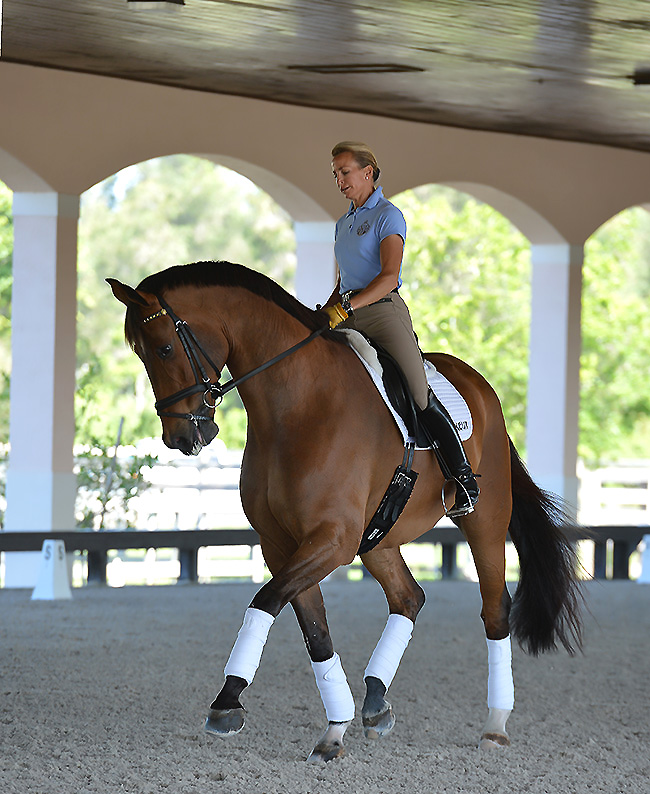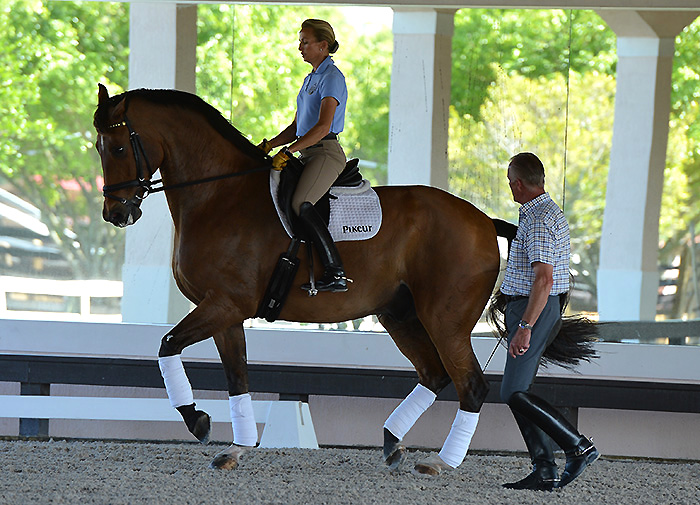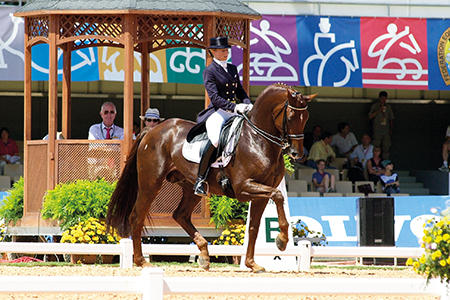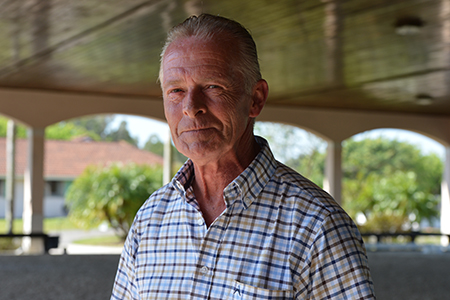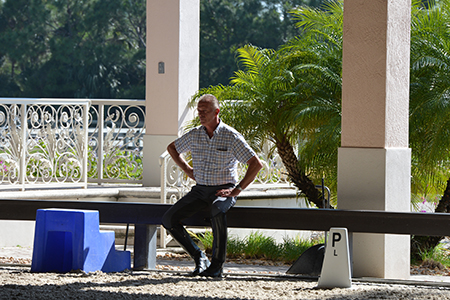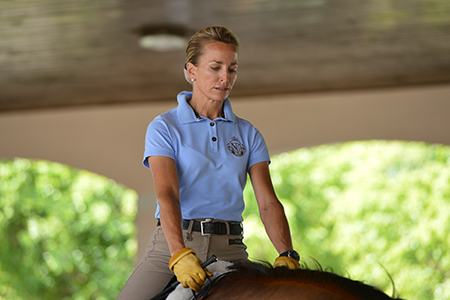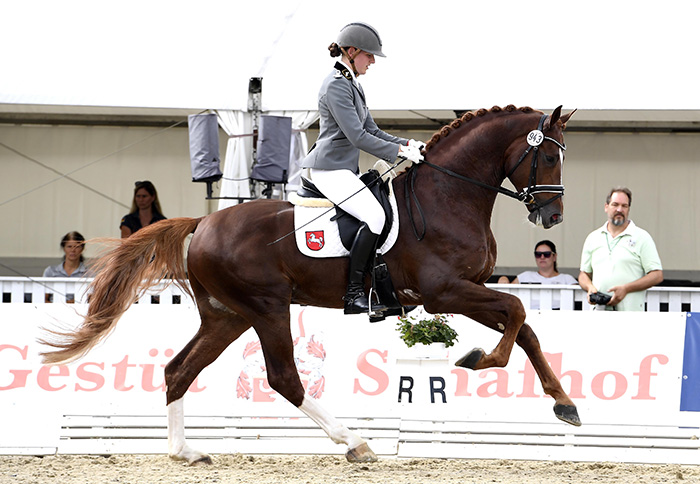Chris Hector sits in on a working session with Lisa Wilcox and Ernst Hoyos:
When we last visited Lisa Wilcox and Ernst Hoyos in Florida in 2013, but it took only seconds for me to remember what a special experience it is. Ernst brings to the world of competitive dressage, 29 years of experience with the Spanish Riding School, and in Lisa, he has found the perfect muse, a rider who absorbs every word, and while Ernst is reluctant to talk – in English at least – about his art, Lisa is just about the most articulate dressage rider in the world.
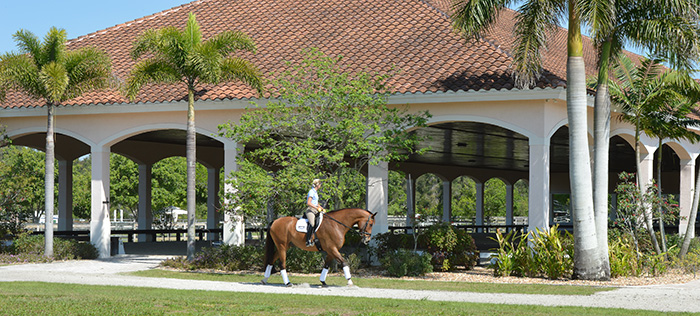
We meet Lisa at one of those Florida horse complexes that have made Wellington the equestrian centre of the USA – the extremely beautiful Marsh Pond Farm, where she is working with the owner, Jacqueline Shear and Galant, her seven-year old Escudo / De Niro gelding.
Lisa is riding, Denzello, a ten-year-old Hanoverian, owned by her Canadian friend, Betty Wells. The bay is by De Niro out of a mare by Rohdiamant, the stallion that Lisa rode in World Cups when she was based at the famous Vorwerk Stud in Oldenburg. Denzello is working towards his first Grand Prix start, with only the ones left to master.
Now either Lisa has got smaller since we saw her last, or this is a very big horse. He is! Eighteen hands, but it is amazing how quickly he finds his balance with the petite blonde in the saddle. Lisa had warned me before she got on, that the warmup might involve some work with the horse’s nose behind the vertical – and it does – but this is a far cry from the pulling back behind the vertical with the spur dug into the horse’s side.
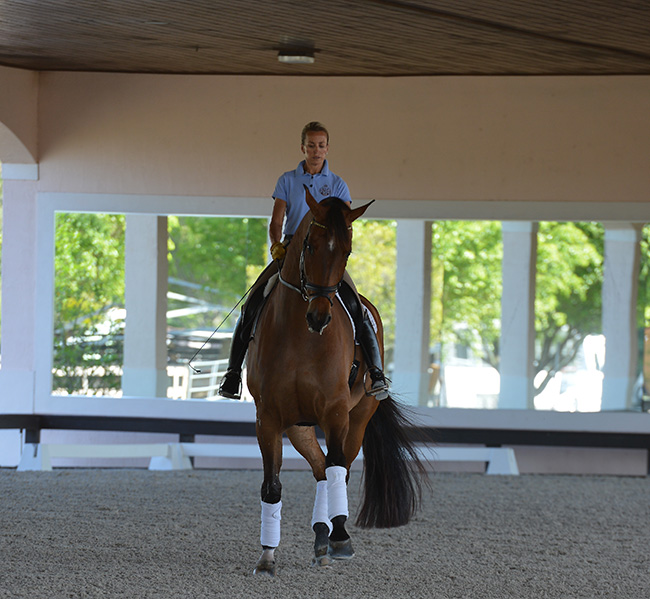
Lisa is flexing the big horse, in / out and now into shoulder-in, and shoulder-in in passage, the transition to passage so seamless that I wonder if it is the horse’s own idea? ‘Not so – mine,’ Lisa, tells me later.
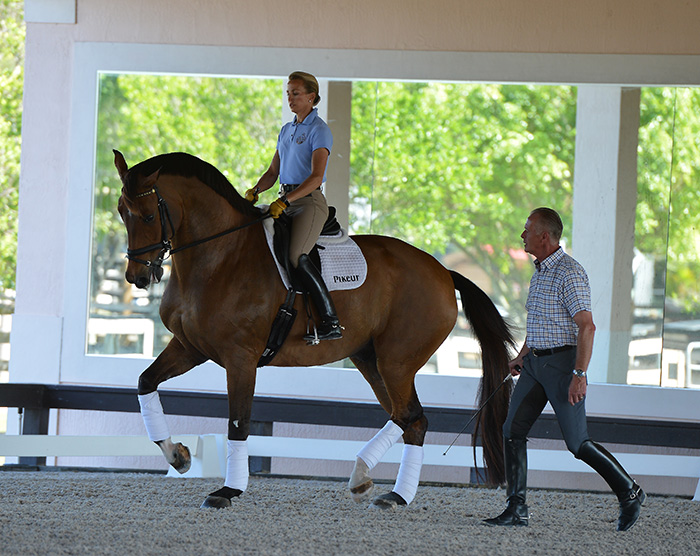
Suddenly the big, slightly dopey looking bay is starting to dance. And Ernst’s teaching style is classic European. A word here or there, a jawohl when it happens right. Ernst is teaching in German, he once explained to me that he would hate to have to teach in English because there are just not the words in that language to convey exactly what he means. Really we could be back in Oldenburg, at Cappeln, except for the palms and the Everglades in the distance.
The horse is showing some wonderful big rhythmic piaffe, how could I have forgotten how beautifully Lisa sits? She is so centered in her core, so supple through her back, her calf so beautifully just brushing the horse, when they go into a pirouette, I am reminded of the famous photo of Podhajsky, the body position is exactly the same… little wonder I guess, since Ernst learnt his craft in the tradition of Podhajsky and the School in Vienna.
Now Ernst is on the ground with the long whip. There is no drama, the whip is barely touching the horse, it is all a matter of exquisite timing. The first passage is a bit piaffey, Ernst moves further away, and the movement comes slower and looser, now it is truly passage and Ernst is just walking beside the horse.
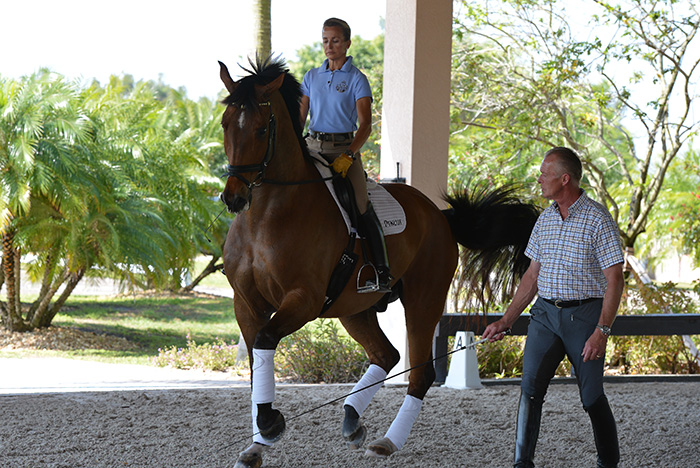
How subtly Lisa brings the horse back from passage to piaffe, the aids are truly invisible and when I remark how subtle the change is, she laughs…
“Thanks I’ve been working on that since I saw you last. The goal in Ernst’s training is through the core, and a very light help with your lower leg, and I am squeezing my fist, squeezing, relaxing the ring finger. I’ll balance him on my outside rein, release the tension in the inside rein periodically by relaxing in the elbow, allowing my arm to go forward and creating a bit of a loopy rein. When I feel him lose his balance, then I’ve got both reins evenly weighted again to help solidify and regain the balance.”
“The key is – no rhythm mistakes, and for that, the quieter you are with these big animals the better, because it doesn’t take much to throw them off balance in that degree of collection. The quieter I am the better, through my seat, my leg – no over-aiding, quiet aids. It all depends on how much I feel he is in front of the weight of my seat, my core is 80% of my driving aid, if I can balance my core weight directly over my hips, my seat bones become properly weighted to then produce an effective 80% driving aid. If he comes behind my driving seat, my outside leg must assist to activate the outside hind leg in a tactful way that does not disturb the balance or rhythm of the horse. This is why it is important to be ahead of the situation and be there with my driving leg before the loss of impulsion disrupts the movement and the horse falls on the forehand.”

“Try to be ahead of the feeling you’ve got, if they get imbalanced, then they start to hang on a rein, and the minute they’ve done that, they become hard in your hand – that’s what happens when they get behind your seat. When you have them through the poll, elastic in the throat latch, and it’s all soft, that’s when you have fluid flowing energy from the hind leg to the contact – from back to front. You only get the block of energy when you feel him hardening to your hand for a second, then I have to use precise technique and come with short, quick, tactful impulses with my leg because I don’t want to produce balance or rhythm issues. You want to come with the appropriate aids to correct, rather than coming too much like an elephant in a china closet and you just ruin the whole thing.”
When you started coming out of the piaffe work with Ernst and went to passage, it was really advancing piaffe, and it was so interesting that when Ernst backed off, the rhythm became slower and it was more truly passage…
“Right now with this horse, where he is in his learning phase, he is a little stuck in his balance and often he can’t come out of the piaffe yet. He’s trying to figure out what to do, so the rider’s thought process is think trot leaving the piaffe, he’s not going to lose all that suspension and really go off in trot, he is just going to begin to passage. And you need to take that time and space when you are developing the horse, they can’t be pushed in the transitions. The transitions are very valuable points, and they are the ones that are most critical.”
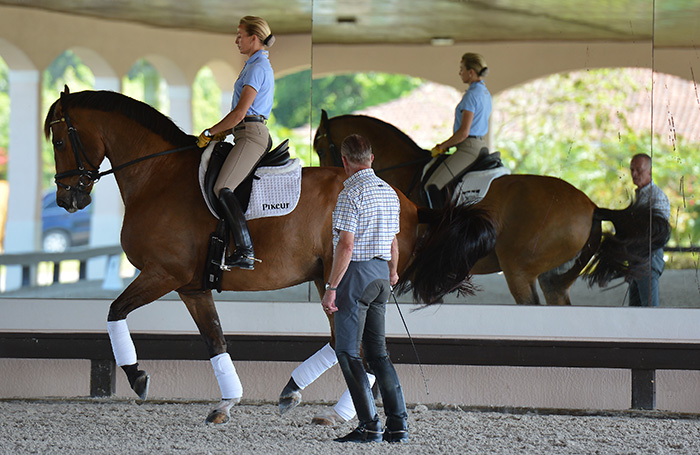
“Once they are in a movement, okay we’re stable, it’s the transition in and out where it gets tricky and they need that strength and balance. That’s when the rider has to be on the aids and quiet, and wait, patient. You have to be patient, and if it takes you ten metres to get out of piaffe, and you are forward in advancing piaffe until it becomes passage, then the horse goes ah click! Pat good boy. Okay I get it…”
“They are trying to figure out the transition, and it becomes more difficult the more expression they have, it gets fragile.”
But lots of people don’t recognize the difference between advancing piaffe, and passage…
“That’s right and that’s why there are a lot of frustrated horses. You get horses that just stop. They are held into the piaffe and kicked, rather than allowed to find their balance in piaffe. I remember back when I was riding Relevant, I had just taken over the ride from Nicole Uphoff and started showing Grand Prix, my piaffes were quarter line to quarter line because he had a severe panic of being on the spot. In order to re-train that thinking, I let him go forward, got my 4s, and then went into passage. He was a happy camper, and I was very happy that he was happy in his test, and it wasn’t about the score, it was about re-training the thinking in that particular area of the test. Allowing him to advance, he took a big deep breath okay I’m not trapped any more… He had all that power but he wasn’t in a place to be able to understand how to keep it there, and especially with the rider.”
Lisa and Relevant competing at the 2002 WEG in Jerez
“With Ernst, the proof is in the results, and especially with the in-hand work, that can be a very tricky thing. The horse I rode today is electric to anyone on the ground, so I never have asked anyone to help work him from the ground. When his owner, Betty, was riding the horse once, she found herself in a frightful situation, where the horse was whackety whacked by someone with no feeling. What is so important is that distance between the horse and the person on the ground, there is a lot going on there… Monty Roberts stuff that we do naturally being horsemen. If you are watching their eye and they are a little worried about you, you back out to zones where they become more comfortable. You watched Ernst change the parameters all the time depending on what he was reading in Dino. I didn’t have to tell Ernst, oh back off something is coming up, no – he can read the horse and he appropriately places himself, and you see the horse relax.”
The first passage you got on the wall out of left trot shoulder in, was that his idea or yours?
“Mine, because I was losing the shoulder and the control over the right side, he was drifting, and I was getting rhythm issues, and no fluid forward, he was crooked. Often what we will do then is piaffe or passage in shoulder fore. To get control of the outside shoulder, and that is what dressage is really all about. The outside shoulder is how you steer a horse, if it is the pirouette, or the half pass, anything we do, I shoulder-fore first, now I have the shoulder I can go off in my half pass.”
It was interesting last issue, we had a photo of Podhajsky in pirouette, and when I looked at you in pirouette, it was I’ve seen this before… there is a pole through the rider’s body…
“That is correct. I like to think of it as a pole through my shoulder, my hip and my heel and if I am tracking left, my left or inside seat bone becomes more weighted by my stepping with two thirds of my weight into my left stirrup iron, creating bend in the left side of the horse’s vertebrae. He is skewered, through me, through my seat bone to my heel, and he canters around that.
At the beginning you were joking about rolkur, but with you it is different because of your timing….
“Correct, the giving of the hand. Sometimes when not so educated viewers, see the horse behind the vertical they think it is rolkur. But I’m with you, what I do is not rolkur, it is getting a horse through and over his back by softening and releasing tension in the base of the neck muscles, encouraging them to reach or lengthen the neck to the contact, not hide from it.. You have to go a little behind the vertical to get that done but it’s the feeling, the timing, it’s not holding them and locking up the base of the neck so the back drops. I’m looking to release the base of the neck, so the back comes up. I want the bow up into me, not to brace and hold and have the false break of the neck, and the chin on the chest. To do that would be completely against what I am trying to achieve.”
I find Ernst such an incredible trainer, after all these years are you still learning more?
“Yes, still advancing. You’d laugh but there are many times when I’ll go that’s what he was talking about, all those years ago. I think you can better your balanced seat through a strong, elastic stable core. Every horse you ride confronts you with your weaknesses, they’ll bring them out of you and show you where you are weak. Some horses are perfect for your balance, and some horses are not balanced and show you where you are not balanced. I’m working every day on my seat with every single horse: that I stay bi-lateral, that I have as good an outside right rein as I do an outside left rein.”
Ernst Hoyos, one of the great masters of in-hand work, prefers teaching in German
They must hate Ernst here in the United States, he says one word every five minutes, and Americans are so used to the continual running verbal diarrhea…
“He hates it when he watches me teaching – ‘You talk too much.’ But what I have found is that it is very difficult in our language to have a precise lesson, and you end up having diarrhea of the mouth because one word in German takes me a paragraph. Losgelassenheit, jawohl. So I get to explain that in English, it’s tough.”
I can remember Ernst saying to me once that he didn’t want to teach in English because the words were just not that, that in German there were half a dozen words to describe what was happening in a half pass…
“And in half a second. This is something I’ve worked on, how I can most closely translate with the fewest words, that’s been my teaching goal. It is not easy.”
And you train in German with Ernst?
“No question, I would always want to train in German with him, because it is so quick and to the point. He has to learn a little English for when he is teaching my clients, and I will sit on the sidelines and translate if I think I see their eyes glazing over. He’ll say ‘Loosen your Ober leg, upper thigh, or halbe parade, it’s a half halt, but it is good for them to learn the German.”
I was amazed and horrified one time, when one of our dressage team members who was in the ill-fated Ulla training camp before the Aachen WEG, said, oh yeah, the piaffe man came to visit! I thought I guess that is why you ride so badly because you can’t even see what Ernst has to offer, and that is why you will never get any better. The real thing he teaches is the seat…
“It’s everything we do, it is real horsemanship and understanding each individual horse and working within that horse’s individual mental capacity so that it would like to do the job. Like the mare I ride, I try to get a smile on her face every day, and Ernst knows how work with that – she can’t be worked for a prolonged period of time, you’ve got to get what you want, give her a pat, give her a rest and let her know that was what you wanted. Dig a little deeper than the surface, on each ride we have.”
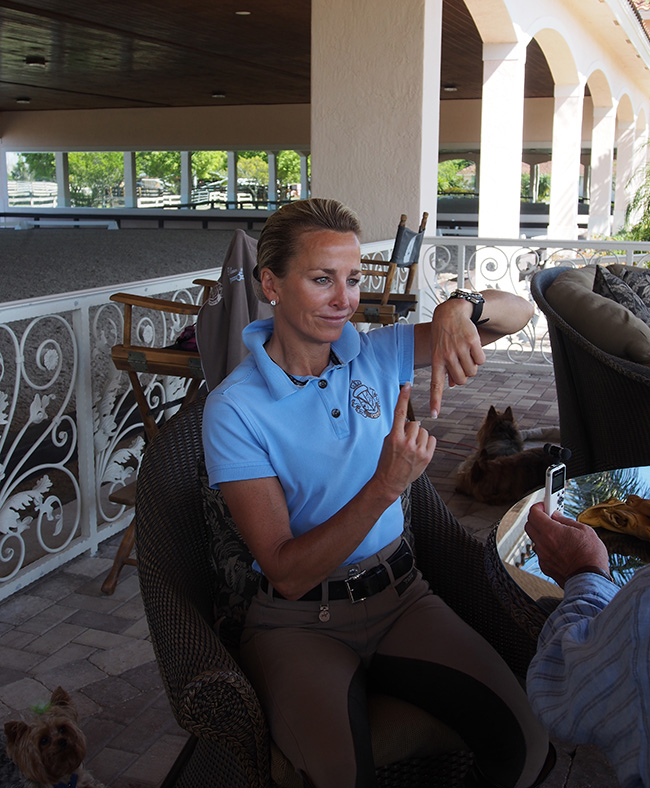
Postscript from Lisa in 2020
The Spanish Riding School brings with it the art of Classical Dressage. The Seat and it’s effectiveness is one of the Spanish Riding Schools prime focuses. Ernst has spent hours working on perfecting my seat, and still focuses on my seat to this day!
This is our language when communicating with horses. Ernst has always been one to think outside the box to improve his own training skills. Studying closely the horses and their natural instincts taught Ernst to be a very patient and sympathetic trainer of the horse. ‘We have time’, was something Ernst would always tell me while we trained. I’m sure he could sense my anxiety as we approached show dates that I felt my horse & I were not ready for. I hear these words in my mind daily while I’m training. Ernst literally stepped outside the box so to speak to further educate himself teaming up with Jo Hinnemann. Ernst and Jo have a long standing friendship and immense respect for one another. Ernst would often spend his free weekends training side by side with Jo at his farm in Germany when he was at the Spanish Riding School. Top riders from both Germany and Holland would bring their horses to Jo and Ernst for training. They would together train the horses teaching them piaffe, passage, changes and all the Grand Prix movements. Jo and Ernst would spend their evenings in front of the fireplace with glasses of the best red wine philosophizing about that days dressage training.
Exchanging ideas and information from their personal training experiences as well as from information they read from Masters before them.
True ‘Masters’ in dressage are artists capable of taking their knowledge and skill, developed over their lifetimes, to create a horse and rider that demonstrate a breathtaking, effortless, joyful presentation of all movements required in the Grand Prix.
Ernst Hoyos has been a Dressage Master for me.
Ernst has always pushed me to raise my skill level to it’s absolute optimal level, requiring immense discipline and concentration.
I am the competitive international rider and trainer I am today because of Ernst and his wealth of knowledge which stems not only from the Spanish Riding School but from his hunger to seek knowledge outside the Spanish Riding School.
Find out what new stallions are available in Australia – stallions like the Vidar :





